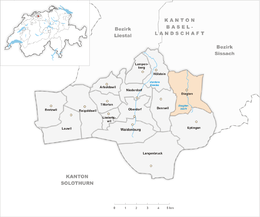Diegten
| Diegten | ||
|---|---|---|
 |
||
|
||
| Coordinates: 47°25′N 7°49′E / 47.417°N 7.817°ECoordinates: 47°25′N 7°49′E / 47.417°N 7.817°E | ||
| Country | Switzerland | |
| Canton | Basel-Landschaft | |
| District | Waldenburg | |
| Area | ||
| • Total | 9.64 km2 (3.72 sq mi) | |
| Elevation | 469 m (1,539 ft) | |
| Population (Mar 2016) | ||
| • Total | 1,644 | |
| • Density | 170/km2 (440/sq mi) | |
| Postal code | 4457 | |
| SFOS number | 2884 | |
| Surrounded by | Bennwil, Eptingen, Hölstein, Känerkinden, Läufelfingen, Tenniken, Wittinsburg | |
| Website |
www SFSO statistics |
|
Diegten is a municipality in the district of Waldenburg in the canton of Basel-Country in Switzerland.
Diegten is first mentioned in 1152 as Dietingoven. In 1213 it was mentioned as Dietikon,in 1342 it was mentioned as Dietken and in 1671 it was Dieckten.
Diegten has an area, as of 2009[update], of 9.64 square kilometers (3.72 sq mi). Of this area, 4.77 km2 (1.84 sq mi) or 49.5% is used for agricultural purposes, while 3.81 km2 (1.47 sq mi) or 39.5% is forested. Of the rest of the land, 1.07 km2 (0.41 sq mi) or 11.1% is settled (buildings or roads).
Of the built up area, housing and buildings made up 4.6% and transportation infrastructure made up 5.5%. Out of the forested land, 37.6% of the total land area is heavily forested and 2.0% is covered with orchards or small clusters of trees. Of the agricultural land, 25.5% is used for growing crops and 19.1% is pastures, while 4.9% is used for orchards or vine crops.
The municipality is located in the Waldenburg district, in the Diegter valley. It consists of a 2 km (1.2 mi) long string of five linear villages; Ober-Diegten, Mühle-Diegten, Mittel-Diegten, Schloss-Diegten and Nieder-Diegten.
The blazon of the municipal coat of arms is Per pale, Or a Lion rampant Sable, and Bendy of six Sable and Argent.
Diegten has a population (as of March 2016[update]) of 1,644. As of 2008[update], 7.6% of the population are resident foreign nationals. Over the last 10 years (1997–2007) the population has changed at a rate of 13.7%.
Most of the population (as of 2000[update]) speaks German (1,338 or 96.3%), with French being second most common (9 or 0.6%) and French being third (9 or 0.6%).
...
Wikipedia




